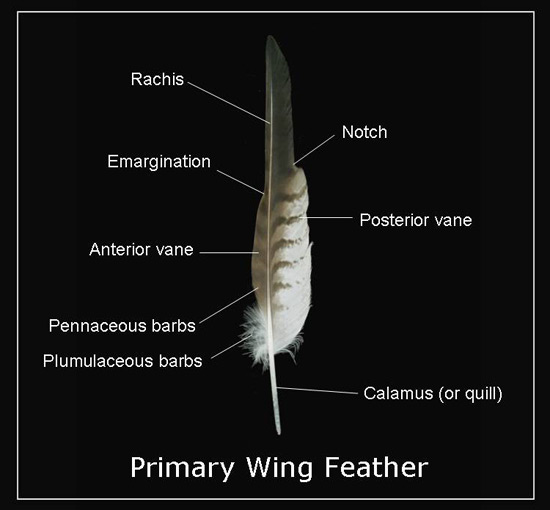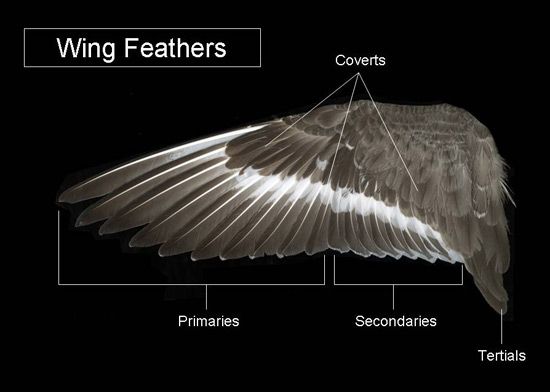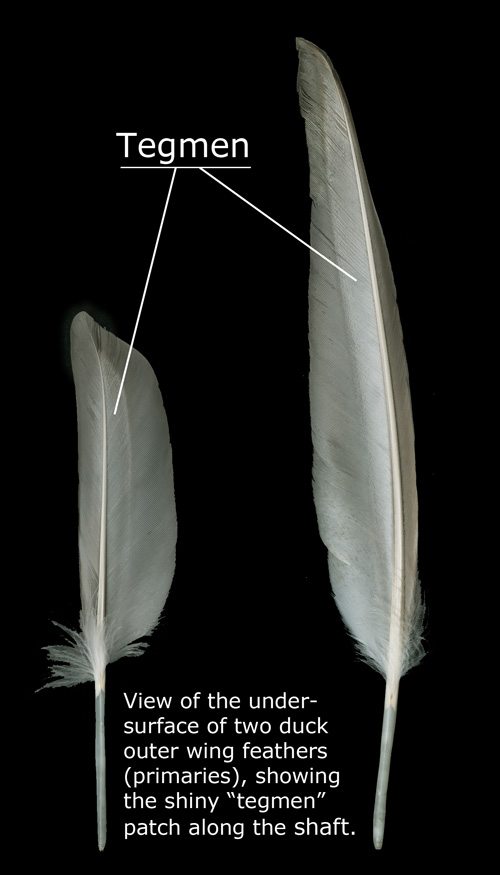| Identify My Feather | Browse Scans | Search Scans | Glossary |


FEATHER TERMS AND ILLUSTRATIONS
Basic terms that describe parts of a feather are illustrated below, and defined in the Glossary.

The major types of wing feathers are illustrated below, and defined in the Glossary

FEATHER ATLAS GLOSSARY
Axillaries: feathers in the axilla ("armpit") of the bird. In some birds, such as Bald Eagle, these are large enough to merit illustration in the Feather Atlas.
Barb: an individual strand of feather material (keratin), extending laterally from the rachis.
Barbule: a lateral branch of a feather barb.
Calamus: the hollow inner portion of the feather shaft that lacks barbs and attaches to the skin. Sometimes called the quill.
Contour Feathers: the feathers forming the bird's outer body covering, including the flight feathers and the overlapping body feathers that produce the bird's smooth aerodynamic shape.
Coverts: the contour feathers that cover the bases of the flight feathers. Those on the upper (dorsal) surface of the body are called upper wing and upper tail coverts; those on the under (ventral) surface are called under wing and under tail coverts. In some birds, such as eagles, these are large enough to merit illustration in the Feather Atlas.
Dorsal: the upper surface of the body, or of any body part oriented in a normal horizontal position. Most scans in the Feather Atlas illustrate the feathers in dorsal view, showing the upper surface of the feathers.
Emargination: a distinct narrowing in the anterior vane of a primary flight feather.
Flight Feathers: the large wing and tail feathers that provide lift and maneuverability in flight (see "Remiges" and "Rectrices").
Immature: a young bird in its first year, before it has acquired adult plumage.
Notch: a distinct narrowing in the posterior vane of a primary flight feather.
Pennaceous Barbs: barbs with interlocking barbules that form a coherent vane.
Plumulaceous Barbs: barbs without interlocking barbules, forming a loose fluffy layer at the base of a contour feather; or making up the entirety of a down feather.
Primary: one of the wing's outer flight feathers, which are attached to the fused bones of the bird's "hand." Most bird species have 9-10 primaries.
Rachis: the upper portion of the feather shaft, to which the barbs are attached.
Remiges: the flight feathers of the wing, including the primaries, secondaries, and tertials.
Rectrices: the flight feathers of the tail. Most bird species have 10-12 rectrices.
Secondary: one of the wing's inner flight feathers, which are attached to the ulna bone in the bird's "forearm." The number of secondaries varies from 9-25 depending on the species.
Subadult: a bird that is not fully adult, in species that require more than one year to achieve adult plumage (e.g. eagles). In such species, age is often estimated by plumage stage (e.g., Subadult I, II, and III for Bald Eagles).
Tegmen: a shiny or waxy-looking patch along the shaft on the underside of primaries of waterfowl and some gamebirds, gulls, and owl. If obvious, usually indicates that a feather is from waterfowl.
Tertial: the innermost flight flight feathers of the wing, attached to the humerus bone in the bird's upper arm. There are usually 3-4 tertials.
Vane: the smooth feather surface formed by the interlocked pennaceous barbs. On remiges, the anterior vane is on the forward side of the rachis (the leading edge). The posterior vane is the trailing edge of the feather.
Ventral: the under surface of the body, or of any body part oriented in a normal horizontal postion. The Feather Atlas illustrates feathers in ventral view only when the under surface is very different from the upper surface (e.g., in Black and Turkey Vultures).

|
Last Updated: April 17, 2023
U.S. Fish and Wildlife Service Home Page | Department of the Interior | USA.gov | About the U.S. Fish and Wildlife Service | Accessibility | Privacy | Notices | Disclaimer | FOIA |
 |
|
